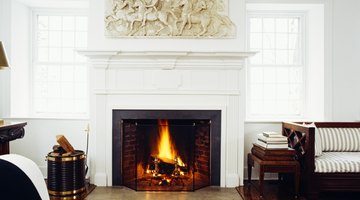Disadvantages of Burning Wood
Table of Contents
The disadvantages of burning wood include the cost and mess of handling firewood, as well as the potential health effects and fire risk associated with burning firewood.

On a cold night, is there anything more appealing than warming up in front of a crackling wood fire? Maybe not, but while burning wood for heat is cozy in the moment, there are some drawbacks that may continue to affect you long after the logs have burned to ash. Weigh the pros and cons before lighting a wood-burning fire or installing a wood-burning stove to heat your home.
Negative Health Effects
Wood smoke contains fine particulate matter as well as pollutants including benzene and formaldehyde — in other words, stuff you really don't want to breathe in. The smoke may trigger asthma or allergies in some people, and breathing it in can harm the heart and lungs. Young people, older adults and people with existing heart and lung conditions may be especially susceptible to the health effects of wood smoke.
The Messy Aftermath
When you turn off a furnace, warm air is the only thing that should remain. But burning wood may leave some splinters or small pieces of bark on your floors, as well as charred logs, ash and soot in your fireplace or stove. Using a wood-burning fireplace or stove indoors also creates a lingering smoke smell that may be hard to get rid of. The mess probably isn't a dealbreaker alone; some people enjoy the smoky odor, and cleaning your fireplace isn't something you need to do after every fire.
Logistics and Cost
Burning wood can be more trouble than it's worth in certain scenarios. Getting wood to your home can be a challenge. Unloading and stacking a cord of firewood is a lot of work and so is transporting wood indoors to your fireplace or stove. (Using a sturdy wood-carrying tote may help somewhat.) People with mobility issues may be unable to safely lift and move firewood or control a lit fire.
With a wood-burning fireplace, building a fire that will actually catch and stay lit can also take several tries. It's certainly easier to turn on a furnace or other heating system than it is to build, light and maintain a wood fire each time it gets cold.
Unless you have access to firewood from your own property, burning wood as a heat source also means paying for wood. This could still be cheaper than using an alternative heating source, but it's worth considering when you're weighing the pros and cons of burning wood. Think about cleaning costs too. When you burn wood in an indoor fireplace, a combustible material called creosote builds up inside the chimney. The chimney should be cleaned annually by a professional to remove creosote since its buildup can cause chimney fires.
Risk of Fire
Burning wood always carries some fire risk. An active fire in a fireplace can throw off sparks and embers that land on carpets, nearby furniture or other flammable materials, letting the fire spread quickly throughout the home. With outdoor fires, wind can blow sparks that land and catch fire on dry brush or wooden structures.
These things can happen in the time it takes you to make a quick bathroom break, which is why a wood fire should never be left unattended by an adult. Always use a protective mesh screen when burning wood in your indoor fireplace, and keep a mesh spark guard on an outdoor fire pit when in use. Burn only dry, well-seasoned wood to minimize smoke and creosote buildup.
References
- National Collaborating Centre for Environmental Health: Reducing Wood Smoke and Protecting Indoor Air Quality Is More Important Than Ever During the COVID-19 Pandemic
- Friendly Fires: How To Reduce Creosote Buildup and Keep Your Fireplace Glass Clean
- United States Environmental Protection Agency: Wood Smoke and Your Health
Writer Bio
Cooking, travel and parenting are three of Kathryn Walsh's passions. She makes chicken nuggets during days nannying, whips up vegetarian feasts at night and road trips on weekends. Her work has appeared to The Syracuse Post-Standard and insider magazine. Walsh received a master's degree in journalism from Syracuse University.
More Articles



